Mark Amery – 5 April, 2018
If this were a recent Te Papa exhibition it might have had an exclamation mark and a question mark attached. Indeed, at the very time Te Papa reveals its new direction, City Gallery provides us with its most pre-Toi Art Te Papa like of shows ever. Not only have parts of several familiar major works that represented New Zealand at the Venice Biennale popped across the road from the Te Papa collection, in theme and mix of the historical and contemporary it is an exhibition you can imagine Te Papa having done. Conversely, it is not the approach we've come to expect of a non-collecting institution with a focus on New Zealand's contemporary edge.
Wellington
Group show
This is New Zealand
Curated by Robert Leonard and Aaron Lister
3 March - 15 July 2018
This rewarding exhibition is both rather familiar and necessary. Familiar is the most common word I’ve heard used by others. Yet, for all who roll their eyes at the roll call of lads—Denny, Parekowhai, Hipkins, Stevenson and McDonald—and the flags of the 2016 NZ Flag Referendum flying above the Wellington Town Hall, discussion is opened out on a shared past. In a government town, a theme of national image and what it conceals, and the diplomatic role of the arts is a strong fit. Let’s just hope it leads to further exhibitions on contemporary themes of substantial political and social import. There’s a big hole where we’re not exploring what New Zealand is today.
For the title This is New Zealand comes with a question mark missing. The opening wall text even says so. Curators Robert Leonard and Aaron Lister smartly posit this as a show as much about what is excluded as included. The question mark would have helped that. This is New Zealand reframes what’s included in the national account and raises questions around it.
Cribbed from filmmaker Hugh Macdonald’s famous panoramic Osaka Expo ‘70 film of the same name (which appears in the exhibition) the title speaks to the punchy, rallying the “we are New Zealand” scriptwriting of the New Zealand Film Unit. Perhaps it’s a measure of how far we’ve shifted from this nationbuilding rhetoric that many are capable of supplying the punctuation; that we might collectively, as if at a pantomime, reply to the statement ‘This is New Zealand’, with “Oh no, it isn’t”.
If this were a recent Te Papa exhibition it might have had an exclamation mark and a question mark attached. Indeed, at the very time Te Papa reveals its new direction, City Gallery provides us with its most pre-Toi Art Te Papa like of shows ever. Not only have parts of several familiar major works that represented New Zealand at the Venice Biennale popped across the road from the Te Papa collection (this is the second time Michael Stevenson’s This is the Trekka has taken up sizeable garage space at City Gallery), in theme and mix of the historical and contemporary it is an exhibition you can imagine Te Papa having done. Conversely, it is not the approach we’ve come to expect of a non-collecting institution with a focus on New Zealand’s contemporary edge.
Downstairs the exhibition is neatly two-winged. The east gallery has This is the Trekka—in a trade expo style installation—walled in by butter boxes and with various trade stands, revealing how this New Zealand made 1960s vehicle was powered by a soviet engine. As Leonard notes, New Zealand was trading behind the Iron Curtain. This is the first of several works in the exhibition where artists counterpoint marketing image and covert political operation. Compared to Stevenson’s current Serene Velocity in Practice, this work now seems rather overt in its pointmaking, but it’s important to the exhibition.
The west gallery is devoted to the image we once projected to the world of ourselves—works commissioned to represent us at world fairs, expos and in other diplomatic contexts. Included is John Drawbridge’s large abstract New Zealand House Mural (created for the High Commission in London), all awkwardly shifting cut up planes, where European abstraction is collaged with references to the green koru and blue light-soaked horizon lines.
Elsewhere there are plenty of interesting artefacts: Marcus King’s 1938 poignant illustrative painting of the arrival of Maori, the double waka touching down as figures take their first sip of clean New Zealand water, has its current resonances; a film excerpt from Hugh Macdonald’s documentary This Is Expo (1971) of Expo ‘70’s New Zealand Ballet performance Green Are The Islands, with their lovely Para Matchitt costumes (worn in photographs by European dancers). “Life went on after the European arrived,” says the film’s commentator, “upon which events we make no comment.”
Humming in the middle of the ground floor is Gavin Hipkins’ terrific The Homely 2, a sequel to his frieze of 80 images first shown at City Gallery back in 2001. This version is perhaps even better than the much lauded original. While the first was shot on travels through New Zealand and Australia, this version cuts together images taken here and in the UK. The Homely’s charge remains the eery, funny space of feeling culturally inbetween as a Pakeha tourist, a viewer of sites, memorials and memorabilia. An unsettled meditation on what it means to be a colonial, with images abutted together in punk surrealist formation, our usual mapping coordinates are lost. What is England and what is New Zealand becomes blurred. The obviously significant or most central to a pictorial image goes skew whiff. Time collapses.
A central image could be that of Hinemihi, the Tarawera wharenui transplanted to the grounds of Clandon Estate near Guildford, Surrey (also previously captured by Mark Adams). Here this house sits, a tarpaulin covering part of its roof, under a towering oak tree with two English park benches on either side.
However part of The Homely‘s strength is that there is no lead image, no one story. Instead it revels in providing multiple conceptual and formal aesthetic groupings, playfully opening out oblique associations through colours, shapes, objects and subjects, both poignant and comic. Part of the playfulness is pushing the bounds of what a good photograph should be—light reflected off glass, in a photograph of a photograph of a young Charles and Di. The Homely 2 sits well here because this is an exhibition about reframing familiar images and familiar works of art.
In terms of national branding and what it serves, things get more interesting upstairs, particularly in the conversation between the work of Simon Denny and Bronwyn Holloway Smith.
A different, more coherent section of Simon Denny’s Secret Power than that previously shown at Te Papa is presented. A booth contains server racks, models of the NSA and GCHQ headquarters and the Waihopai Spy Station, the flags of the Five Eyes intelligence network nations, and a cheesy pictorial tourist map of New Zealand Denny commissioned from former NSA employee illustrator David Darchicourt. The map is key. It features a cheeky medley of everything from grapes and the Beehive, to skiers and fishermen, figures in Jetsons style tech getups on surf boards, and the internet Southern Cross cable lines coming into New Zealand. This is New Zealand as aimed at wealthy Americans looking for investment.
Wellington also finally gets to see Denny’s 2012 installation Channel Document (which with the selected Secret Power excerpt perhaps makes Denny look not as apolitical as he has been criticized for being). The work rather brilliantly brings together an account, on glass slides, of the shortlived New Zealand public television channel TVNZ 7, and the launch during that same period of a new New Zealand passport, with its intricate graphic telling of the story of New Zealand, and new electronic security chip as required by American security. Between these two events space is created to consider how technological advances and national imaging have cloaked the erosion of public media, and our freedom from commercial and foreign influence and surveillance. Denny’s overly fussy visual layering and his compulsion to add-on layers of complexity can be a little tiring, but the reflection provided is brilliant.
Bronwyn Holloway Smith re-presents a 1961 mural Te Ika a Maui by E Mervyn Taylor that could have been straight out of the new passport. Aptly depicting Maui pulling up a line, it used to hang in a Northcote landing station, once public but now off limits, where the Southern Cross Cable (once the COMPAC cable) comes in from Takapuna Beach.
The Southern Cross Cable: A Tour posits the artist, like Denny, as reporter cum exhibition maker undertaking a piece of creative reverse espionage. The installation collects together disparate faux-documentary elements where it is not always clear whether they are fabricated or not. They include video of Holloway Smith diving to the Southern Cross Cable on the Hauraki Gulf sea bottom, white painted timber posts memoralising the different cables that have connected New Zealand to the world globally (a little unnecessary visual frill), a booklet, and arguably the key work, a video presentation detailing Operation Speargun and the facililties put in place for the GCSB to conduct surveillance infiltrating the Southern Cross cable at its other landing point at Whenuapai airfield. There are parallels again with Denny’s commissioning of a news report. But here, as if in some alternate national film unit, the narrator at the end can quietly be heard to remark off-mic something along the lines of “Why is there still a knot in my stomach?”
This work isn’t subtle, but it adventurously explores an important subject in ways that cleverly physicalise and visualise the unseen.
A little more of a thematic stretch is Michael Parekowhai’s series The Consolation of Philosophy, photographs of flower arrangements memoralising battlefields where the Maori batallion fought—again, showing at City Gallery for its second time. The realisation that these are fake flowers is part the charge here, and they do provide strong framing for conversation about the exchange between Europe and Maori for his brilliant red piano He Kōrero Pūrākau mō te Awanui o te Motu: Story of a New Zealand River. These works are neatly paired under this subtheme with Fiona Pardington’s beautiful smoldering images of hei tiki, which in 2005 were gifted to the Musée de Quai Branly in Paris in a clever form of cultural diplomacy: images of objects regaining their Maori framing as part of the wider exchange that has seen prized taonga returned from European museums.
Interesting incidents of cultural diplomacy like this, peppered through the show, are easily missed next to the likes of Denny. Other single works shine in their role as connectors in the show—Marcus King’s iconic image of Maori signing the treaty surrounded by European and a dressing of flags—a nice touch next to Secret Power. Peter Peryer’s Dead Steer (cow stiff, on the side of the road legs in the air) included for having caused the New Zealand Embassy to withdraw support for his solo exhibition in Germany in 1996. The exhibition was first shown at City Gallery that same year.
Everywhere you turn in this show, the curators are recontextualising the previously displayed. It’s again emphasised by the inclusion of Emil McAvoy’s The National Basement, in which the artist has re-presented documentation of New Zealand promotional displays from the National Publicity Studios from the 1940s to 1980s. It’s a worthwhile, interesting exercise, but all the bite has gone out of the topic by the time I’ve reached this far end of the exhibition.
What’s absent from this show? Te Maori. The 100% Pure New Zealand tourism campaign and work that talks to it. Discussion of our image and relations in the Asia Pacific region. Then there’s what marks us internally today: housing, immigration, our relationship to our environment, our bicultural foundation in relationship to multiculturalism and globalism. This is New Zealand is welcome for asking questions of the familiar. But it left me longing for more exhibitions in Wellington that follow the lead of artists in questioning aspects of the image we project to ourselves today.
Mark Amery
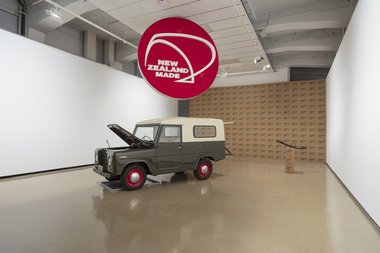
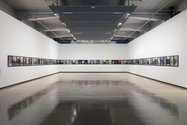
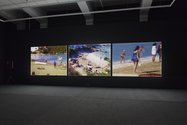
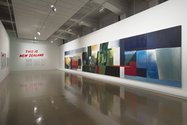
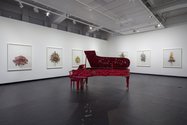
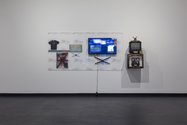
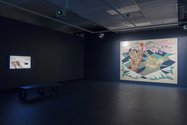
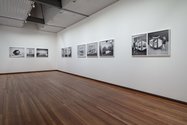
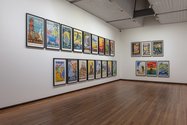
 Advertising in this column
Advertising in this column Two Rooms presents a program of residencies and projects
Two Rooms presents a program of residencies and projects


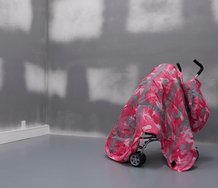
This Discussion has 0 comments.
Comment
Participate
Register to Participate.
Sign in
Sign in to an existing account.